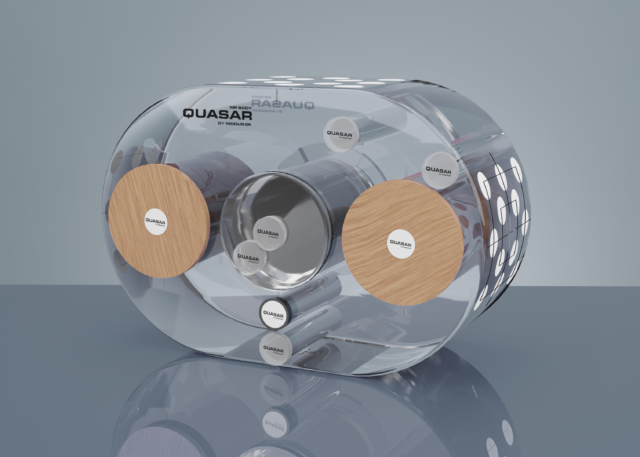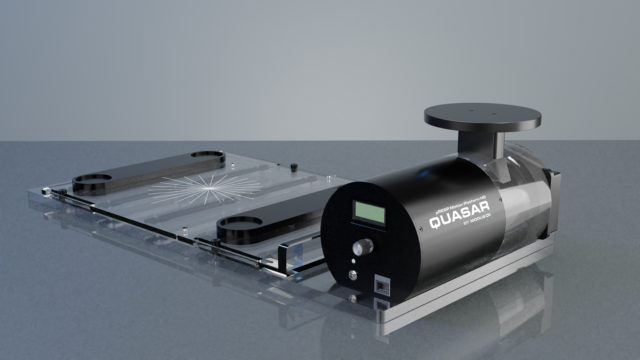


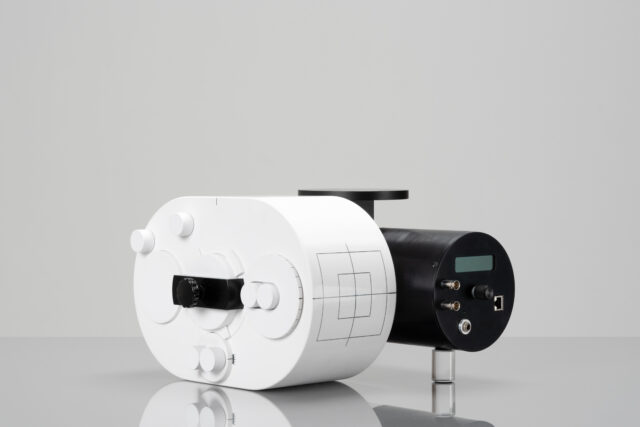


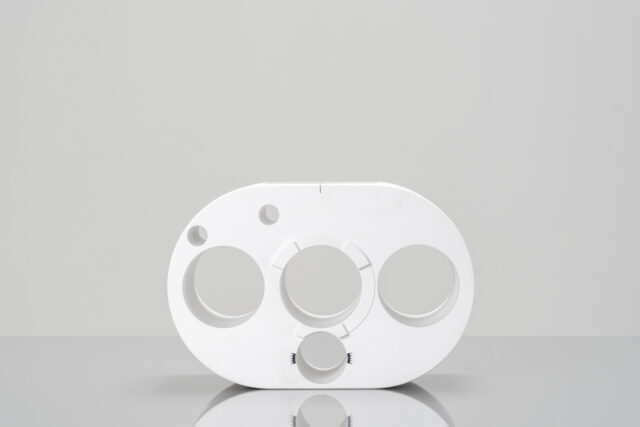


QUASAR™ Respiratory Motion Phantom (pRESP 2.0)
An intuitive tool offering comprehensive testing capabilities.
Conduct end-to-end motion management QA with ease and precision.
Compatible with Machine/Modality/Application:
Adaptive, C-arm linacs, CBCT, CT Simulation, Bore-type linacs, Hypersight, IGRT, Motion Management, Small Field Dosimetry, SGRT, Helical linac, TG51, TG142, Machine Targeting
Used for Workflow:
Imaging QA RT, Commissioning and Annual QA RT, Motion Management MQA, Motion Management MQA
Learn more on the IBA website: Motion Management QA: IBA Dosimetry
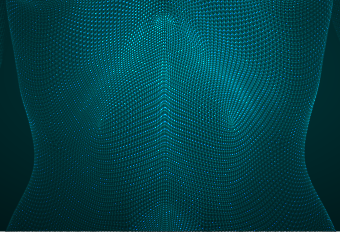
Integrate your motion QA with the leaders in SGRT.
The QUASAR Respiratory Motion Phantom features a vertical chest-wall platform that is compatible with a number of Surface Guided Radiation Therapy Systems (SGRT), such as: Vision RT, C-RAD, Brainlab, and Varian Identify. Easily import patient-specific waveforms from various motion capture and waveform generating sources. Compatible with the following file formats: VXP, .CSV, .TXT, .DCM, .LOG, .DAF, .IMA
-
Specifications
- Body Oval: 30 cm wide, 20 cm high, 12 cm long, RW3, 4.3 kg.
- Drive unit :30 cm long, 30 cm wide, 12 cm high, 4 kg, RW3 in field of view.
- Respiratory Phantom mass: approximately 11 kg with Body Oval and all options.
- Three openings in Body Oval for static insert, drive unit and moving Insert, 8 cm diameter.
- Chest Wall Platform; 13 cm diameter, carries up to 1 kg.
- Power Supply; Input, 100–240VAC, 47–63 Hz, International power cords available on request. Output, 24VDC, 2.1 A, 50 W. Approvals; CE, cUL
-
Optional Accessories
- 500-3330, RESP-Rotation Stage.
- 500-3402, Electron Density Ring water equivalent.
- 500-3185, MP/pRESP-Two Piece holder for MOSFET.
-
Minimum Technical Requirements
- Operating System: Windows 10 or 11.
- Ports: 1 Ethernet
-
100-1011: QUASAR™ Respiratory Motion Phantom
- 1-Phantom
- 1-Software License
-
Optional Inserts
- Please refer to website: https://www.iba-dosimetry.com/product/quasar-presp
Features
End-to-End Dosimetric Confidence
Ensure accuracy in motion-affected treatments with our new water-equivalent phantom. Featuring 6+ ion chamber positions and customizable drillable inserts, it empowers clinicians to precisely measure and verify delivered dose. Resulting in greater confidence in system performance and trust that patients are receiving the treatment exactly as intended.
Simplicity
An easy-to-use phantom with comprehensive testing capabilities for demanding motion protocols in modern radiation therapy departments. From its manual operation mode to its magnetic insert connection, QUASAR pRESP 2.0 is designed with the end user in mind, providing an intuitive motion-management QA tool.
Motion Control Options
Users can select between local manual control at the motor or advanced, software-driven programmability. The phantom supports simple translational motion or complex 3D trajectories when paired with the QUASAR [DH1] Respiratory Motion Rotation Stage (ITEM# 500-3330). Patient-specific waveform testing elevates QA by pushing the limits of motion management systems under realistic conditions.
Motion Precision
Accurate tumor targeting in motion-affected treatments depends on precise respiratory motion replication. QUASAR pRESP 2.0 exhibits detailed sensitivity when replicating captured or created waveforms. A highly responsive motor repositions the translation stage every 10 ms (100x per second) providing real-life breathing replication. Waveforms from 0 to 60 BPM are replicated with ease, testing a large range of clinical protocols. The phantom meets AAPM TG-76 and TG-324 recommendations, ensuring reproducibility and reliability across evolving radiotherapy techniques.
Versatility
QUASAR pRESP 2.0 supports a wide library of interchangeable inserts including water-equivalent, tissue-equivalent, and acrylic options, enabling validation across CT, linac, and PET workflows. Inserts accommodate ion chambers, film cassettes, and OSLD holders for end-to-end dosimetry and Imaging QA.
Software
Included with the QUASAR™ Respiratory Motion Phantom is an intuitive programmable respiratory motion QA software. This locally installed package enables the control of the phantom’s motion and customization of supplied and imported motion waveforms. An incorporated Deep Inspiration Breath Hold Function increases workflow efficiency for users to test DIBH protocols.


Complex Motion Control Options
The QUASAR Respiratory Motion Phantom offers full control of your phantom’s motion profile. Our Respiratory Motion QA Software offers multiple operation modes to increase utility. From adjustable sinusoidal waveforms and simple test patterns to accurate playback of complex 3D waveforms, the pRESP offers the flexibility to choose your motion complexity for your required testing sequence.
Customizable Waveforms
In addition to an extensive library of pre-loaded waveforms, the Respiratory Motion QA Software enables the import of acquired waveforms from a number of respiratory gating and motion tracking systems. The waveforms are completely customizable, improving the user experience when modifying waveform patterns to achieve the desired testing protocol.
Product Information & Accessories
Additional Resources
Effect of later target motion on image registration accuracy in CT-guided helical tomotherapy: A phantom study
MEDWIG J., GAEDE S., BATTISTA J.J., YARTSEV S., Effect of later target motion on image registration accuracy in CT-guided helical tomotherapy: A phantom study, Journal of Medical Imaging and Radiation Oncology 54 (2010) 280-286
Impact of motion velocity on four-dimensional target volumes: A phantom study
NAKAMURA M., NARITA Y., SAWADA A., MATSUGI K., NAKATA M., MATSUO Y., MIZOWAKI T., HIRAOKA M., Impact of motion velocity on four-dimensional target volumes: A phantom study, Med. Phys. 36 (5), May 2009, 1610-1617
Imaging and radiation delivery in helical tomotherapy: Phantom study of a moving target
GALLAGHER, C., YARTSEV, S., VAN DYK, J., Imaging and radiation delivery in helical tomotherapy: Phantom study of a moving target, Poster presented at the 54th Canadian Organization of Medical Physicists (COMP) Annual Meeting, June 25-28, 2008, Quebec, QC, Canada
The Effect of Target Motion on Megavoltage CT Registration
MEDWIG, J., YARTSEV, S., VAN DYK, J., The Effect of Target Motion on Megavoltage CT Registration, Poster presented at Research Day 2008, Lawson Health Research Institute, March 26, 2008, London, ON, Canada
The management of respiratory motion in radiation oncology report of AAPM Task Group 76
KEALL P.J., et.al., The management of respiratory motion in radiation oncology report of AAPM Task Group 76, Med. Phys. 33 (2006) 3874 – 3900.
Dosimetric Considerations in Radiation Therapy of Coin Lesions of the Lung
YORKE E., HARISIADIS L., WESSELS B., AGHDAM H., ALTEMUS R., Dosimetric Considerations in Radiation Therapy of Coin Lesions of the Lung, Int. J. Radiation Oncology Biol. Phys., Vol.34, No. 2, pp. 481–487, 1996.
Monte Carlo dose calculation of segmental IMRT delivery to a moving phantom using dynamic MLC and gating log files
OLIVER M., STARUCH R., GLADWISH A., CRAIG J., CHEN J., WONG E., Monte Carlo dose calculation of segmental IMRT delivery to a moving phantom using dynamic MLC and gating log files, Phys. Med. Biol. 53 (2008) N187–N196.
Motion in radiotherapy: photon therapy
KORREMAN SS., Motion in radiotherapy: photon therapy, Phys Med Biol. 2012 Nov 20;57(23):R161-R191.
